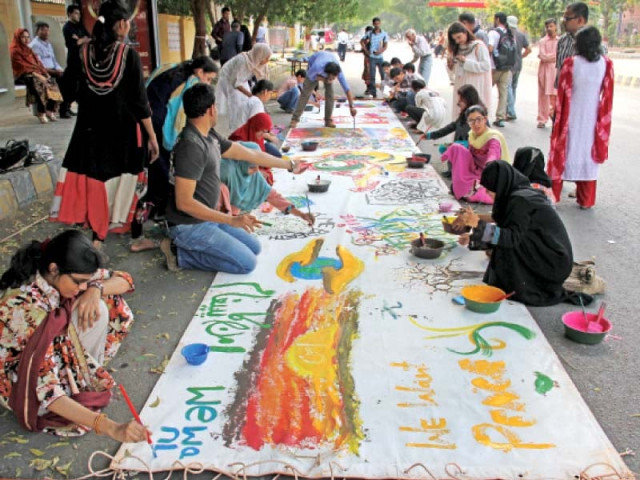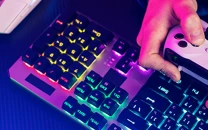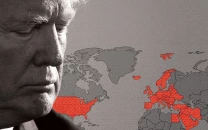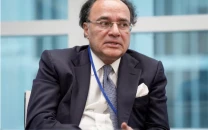Art and the city: Mapping the roads of Karachi for the routes best travelled
Artists Roomi Ahmed, Bani Abidi share how Karachi has influenced their work and career.

Students, artists and other participants took part in the interactive mural painting, titled Aik aur jahan mumkin hai, at the road adjacent to NAPA and the Arts Council. PHOTO: AYESHA MIR/EXPRESS, ATHAR KHAN/EXPRESS
‘Dekh bhaal kay jana’ is a phrase of caution that Karachi’ities have heard one too many times when they’re about to step out of their homes - especially when the halaat [law and order situation] take a turn for the worse as they did in the 1980s when artist Roohi Ahmed used to drive from her house to work.
“I was born and raised in a city which was tolerant and peaceful and was fortunate enough to explore every inch of it - first with my brothers, then the Karachi School of Arts where I studied and then the Indus Valley School of Architecture (IVS) where I teach,” said Ahmed. “But in the late 1970s, soon after Ziaul Haq’s martial law, certain events unfolded which turned the city dark.”

Qawali night, titled Sheher-e-Samaa, was held on Friday evening. PHOTO: AYESHA MIR/EXPRESS, ATHAR KHAN/EXPRESS
Ahmed was part of the panel discussion, Art and the City, which was held at the Arts Council on Saturday. The discussion, moderated by Nafisa Rizvi, was part of the second day of the Pursukoon Karachi Festival taking place at the Karachi Arts Council, National Academy of Performing Arts and Karachi Cantonment Railway Station.
Ahmed spoke of Bushra Zaidi whose death sparked riots in the city, using the tragic incident as an example of how the situation in Karachi spiraled out of control. “I used to drive from my house in North Nazimabad to the IVS in Clifton. The drive served almost as a thermometer for the city, as the city’s temperature would be high in some areas and low in others,” she recalled. That is when Ahmed discovered the “best routes” in Karachi, the one you are forced to take in an instant when you see tyres burning or a mob ahead. Daily bloodshed and turmoil in the city inclined Ahmed to channel her emotions through art, but at the same time, she found it “meaningless”.

Roohi Ahmed’s map of Karachi, titled Dekh bhaal kay jaana, Art installations, under the name of Sheher-e-Munn, were put up in NAPA’s grounds. PHOTO: AYESHA MIR/EXPRESS, ATHAR KHAN/EXPRESS
It was only in 1990, when she was commissioned to authenticate and draw maps of Karachi in a book, that Ahmed knew how she would tell her journey of the city - through the roads she travelled everyday. “I made a series of four maps on the gypsum board and chose the four main routes I used to travel the most. The maps even had geographical entities on the right, indicating the level of yearly anger and yearly fear - it helps understand the psyche of the place,” she explained. “Dekh bhaal kay jaana, a phrase we used to say to each other very often, was the title of the first map.” The other three were titled “Mera hee tou hai” [It (Karachi) is mine], “Dekh magar pyar sey” [Look but with love] and “Diya jalaaye rakhna” [Keep the flame alive].
“I feel these routes are important to all Karachi’ites as they don’t have the option of staying home in fear when there are strikes and riots. After all, we have to go to work and support our families,” said Ahmed.

Painting by one of the participants in Aik aur jahan mumkin hai, A painting, which reads Don’t Destroy Karachi, is part of the many art pieces that have been put up. PHOTO: AYESHA MIR/EXPRESS, ATHAR KHAN/EXPRESS
The second panelist, Bani Abidi, is although a renowned artist but hasn’t lived in the city for the last 20 years, making her a somewhat ill-fitted choice for the panel. However, her work in 2009, titled Karachi-Series 1, spoke of the city and its religious minorities - or as Abidi called them, “the original Karachi’ities.”
“It is very rare to find the city in a lull but in Ramazan, at the time of breaking the fast, the city is quiet and the roads are empty. I took pictures of non-Muslim residents performing everyday activities and chores right in the middle of the roads,” said Abidi. “It was a way of acknowledging that Karachi was their home too.”
Abidi also showed pictures of her series on different intercoms in 13th Street of Khayaban-e-Mujahid and another series on the types of barricades found all over Karachi, saying, “The design analysis of the barricades can tell a person how bad things can get in the city.”

Making way for interactive painting sessions
The MR Kiyani road adjacent to the National Academy of Performing Arts (NAPA) and Karachi Arts Council will remain closed for traffic on Sunday for the third day of the Pursukoon Karachi Festival.
Commuters can use the Aiwan-e-Sadar road, said the traffic police security in-charge. The road, which remained closed on Saturday, will remain closed from 11am onwards today till evening so that the artists can paint on the white sheet in the middle of the road as part of the interactive mural painting session.
“Offices are mostly closed in the area on weekends, so only 35 per cent traffic is seen on these roads on Saturday and Sunday,” said the in charge, Saeed Ahmed, adding that he looked after the traffic in the area on Saturday. “The people who came to the festival followed the traffic rules and parked their cars at the designated spots. This is one of the reasons why there were no traffic jams.”
According to Ahmed Karachi Commissioner has allowed Pursukoon Karachi to block the road for the festival and 10 personnel of the traffic police have been deployed to manage it.
Published in The Express Tribune, November 24th, 2013.



















COMMENTS
Comments are moderated and generally will be posted if they are on-topic and not abusive.
For more information, please see our Comments FAQ